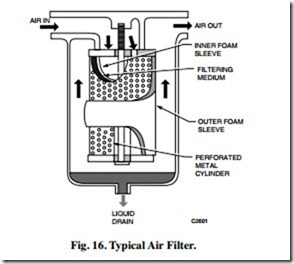PRESSURE REDUCING VALVE STATION
The pressure reducing valve station is typically furnished with an air filter. The filter, high-pressure gage, high pressure relief valve, pressure reducing valve (PRV), and low-pressure gage are usually located together at one point in the system and may be mounted directly on the compressor. The most important elements are the air filter and the PRV.
AIR FILTER
The air filter (Fig. 16) removes solid particulate matter and oil aerosols or mist from the control air.
Oil contamination in compressed air appears as a gas or an aerosol. Gaseous oil usually remains in a vapor state throughout the system and does not interfere with operation of the controls. Aerosols, however, can coalesce while flowing through the system, and turbulence can cause particles to collect in device filters, orifices, and small passages.
Many filters are available to remove solids from the air. However, only an oil-coalescing filter can remove oil aerosols from control air. An oil coalescing filter uses a bonded fibrous material to combine the small particles of oil mist into larger droplets. The coalesced liquids and solids gravitate to the bottom of the outer surface of the filter material, drop off into a sump, and are automatically discharged or manually drained.
The oil coalescing filter continues to coalesce and drain off accumulated oil until solid particles plug the filter. An increase in pressure drop across the filter (to approximately 10 psi) indicates that the filter element needs replacement. For very dirty air, a 5-micron prefilter filters out large particles and increases the life of the final filter element.
in pressure drop across the filter (to approximately 10 psi) indicates that the filter element needs replacement. For very dirty air, a 5-micron prefilter filters out large particles and increases the life of the final filter element.
PRESSURE REDUCING VALVES
A pressure reducing valve station can have a single-pressure reducing valve or a two-pressure reducing valve, depending on the requirements of the system it is supplying.
Single-Pressure Reducing Valve
After it passes though the filter, air enters the PRV (Fig. 11). Inlet pressure ranges from 60 to 150 psi, depending on tank pressures maintained by the compressor. Outlet pressure is adjustable from 0 to 25 psi, depending on the control air requirements. The normal setting is 20 psi.
A safety relief valve is built into some PRV assemblies to protect control system devices if the PRV malfunctions. The valve is typically set to relieve downstream pressures above 24 psi.
